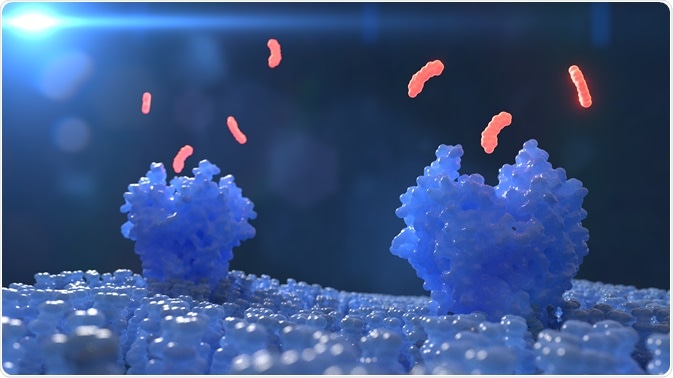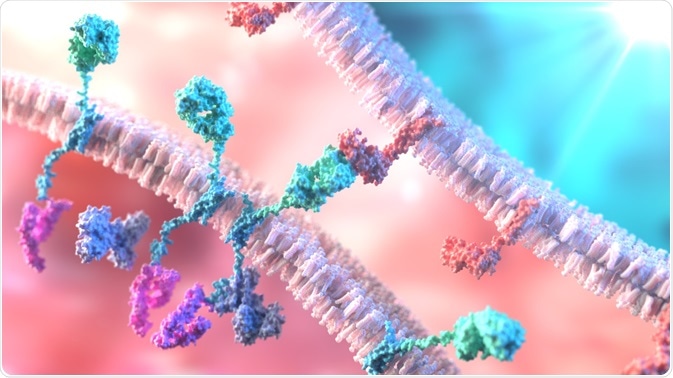In Sri Lanka, cutaneous leishmaniasis, caused by infection with the Leishmania protozoan, is widespread.
Sandflies transmit this disease which creates widespread hardship as the social stigma causes patients to be rejected from society and forced into financial difficulty. Treatments for cutaneous leishmaniasis have low efficacy, and sufferers, once infected, frequently face a lifetime of hardship.
Research recently undertaken has demonstrated that programmed death-ligand 1 (PD-L1) expression predicts clinical response to treatment for patients with leishmaniasis. This has raised hopes that PD-L1 could offer a much-needed host-directed therapeutic with the possibility to cure leishmaniasis.

Image Credit: Shutterstock/Alpha Tauri 3D Graphics
Cutaneous leishmaniasis
Female phlebotomine sandflies transmit Leishmania parasites which cause leishmaniasis, a parasitic tropical disease. The most widespread type of leishmaniasis is cutaneous leishmaniasis (CL), although there are many types.
CL results in skin sores with a range of clinical presentations. They vary from self-healing, basic skin lesions to large, chronic and debilitating recurring lesions.
The lesions can be concentrated on the nose or mouth areas or may present in dispersed areas across the body. The sores usually develop from small bumps to open lesions with a central crater and elevated border (ulcers).
Based on the severity and form of the disease, CL can result in significant social ostracization and, in some examples, physical disability, both of which can result in financial difficulties and hinder an affected person from achieving their full potential.
While CL is not fatal, it can have a traumatizing impact on local communities. Severe social stigma is caused by the disfiguring skin lesions, which can leave chronic scars.
In turn, this can result in economic loss, ostracism and disrupted education. These outcomes are particularly severe because cutaneous leishmaniasis predominantly impacts people who already have low access to resources.1
There are an estimated 600,000 to 1 million new cases of CL each year. The disease is endemic to Sri Lanka.2,3
Strangely, in Sri Lanka, CL can occur due to infection with the Leishmania donovanizymodeme MON-37 parasite that is normally related to visceral leishmaniasis.4
Treatment of CL
While treatments are available for CL, their efficacy can be as low as 50%. Existing drugs also have significant limitations in regards to availability, safety and resistance. The drugs must be taken over a long period of time, are challenging to administer and are not well tolerated.5
Pentavalent antimonials, for example, sodium stibogluconate (SSG), are the first-line drugs for CL. This has been the same for over 70 years when pentavalent antimonial drugs were first discovered, and there has been limited evidence of new and effective treatments emerging.5
In Sri Lanka, CL is especially challenging to treat with available therapies, and even continual intramuscular or intralesional administration of SSG can fail to achieve an improvement.6
In cases that are successful, it can take months of daily or weekly treatment to be cured, and patients usually leave treatment before this time.
There is a critical demand for a safe, oral or topical, inexpensive and well-tolerated treatment for CL that can efficiently cure lesions and can be administered by patients themselves without the requirement for regular clinic visits.
The predictive role of PDL1 in leishmaniasis
A study recently explored gene expression in samples from lesions and blood acquired from sufferers of CL in Sri Lanka, both at presentation and while undergoing SSG treatment.7
The lesion samples showed that SSG treatment resulted in differential expression of immune-related genes, including immune checkpoint molecules.
RNA fluorescence in situ hybridization (FISH) and spatial profiling demonstrated that the expression of indoleamine 2,3-dioxygenase 1 (IDO1) and programmed death-ligand 1 (PD-L1) proteins reduced inside the lesions throughout treatment.7
These checkpoint molecules were also expressed in greater volumes by parasite-infected immune cells compared to non-infected controls.
The research found that decreasing PD-L1 (but not IDO1) expression was predictive of the rate of clinical cure (hazard ratio = 4.88) and mirrored the decrease in parasite load.
It can be observed that the anti-leishmanial activity of antimonial drugs is attained through the reduction in checkpoint inhibition on T cells.
PD-L1 could potentially offer a new treatment method for leishmaniasis as this new data suggests that PD-L1 expression is predictive of clinical response rate to SSG treatment in Sri Lankan CL patients.

Image Credit: Shutterstock/Alpha Tauri 3D Graphics
StataQuest facilitates leishmaniasis research
StrataQuest™ is a modern image processing solution for both fluorescence and brightfield images.8
It can identify nuclei/cells, cellular compartments and tissue structures and can quantify the spatial relationships and proximities on a digital slide. It translates detected objects into comprehensive context-based quantitative analysis.
The practicality of this study heavily depended on the StrataQuest contextual image analysis software. It provided identification of the leishmaniasis parasite, single cell analysis and the analysis of co-expression of IDO1 and PD-L1.9
Measurement of PD-L1, IDO1, CD3 Amastin and CD68 was carried out utilizing StrataQuest Analysis Software, which categorized nuclei according to the signal from the DAPI channel and then constructed and expanded a mask over staining of IDO-1/ PD-L1.
Over 50 StrataQuest Apps are available, which can be employed for automated analysis. The far-ranging potential of StrataQuest can be discovered in the StrataQuest App.
The IF Leishmaniasis APP identifies intracellular Leishmania parasites and separates them in the identified host cells. The number of parasites per cell is established, and dead and living parasites can be identified (live/dead assays).
The IF Dots APP provides the measurement of any dot-sized objects and can be applied to FISH investigations.
References
- Pires M, et al. The impact of leishmaniasis on mental health and psychosocial well-being: A systematic review. PLoS ONE 2019;14(10): e0223313. https://doi.org/10.1371/journal.pone.0223313
- Alvar J, et al. Leishmaniasis Worldwide and Global Estimates of Its Incidence. PLoS ONE 2012;7(5): e35671. https://doi.org/10.1371/journal.pone.0035671
- Athukorale DN, et al. Locally acquired cutaneous leishmaniasis in Sri Lanka. J Trop Med Hyg. 1992;95(6):432–433.
- Ranasinghe S, et al. Leishmania donovani zymodeme MON-37 isolated from an autochthonous visceral leishmaniasis patient in Sri Lanka, Pathogens and Global Health2012;106:7, 421-424. https://www.tandfonline.com/doi/full/10.1179/2047773212Y.0000000054
- Drugs for Neglected Diseases Initiative. Cutaneous leishmaniasis. https://dndi.org/.
- Refai FW, et al. Nonresponsiveness to standard treatment in cutaneous leishmaniasis: A case series from Sri Lanka. Trop Parasitol 2016;6:155-8.
- Nidhi S, et al. Early reduction in PD-L1 expression predicts faster treatment response in human cutaneous leishmaniasis. J Clin Invest. 2021;131(22):e142765. https://doi.org/10.1172/JCI142765
- TissueGnostics. https://tissuegnostics.com/products/contextual-image-analysis/strataquest
- Nidhi S, et al. Supplemental data. https://www.jci.org/articles/view/142765/sd/1
About TissueGnostics
TissueGnostics (TG) is an Austrian company focusing on integrated solutions for high content and/or high throughput scanning and analysis of biomedical, veterinary, natural sciences, and technical microscopy samples.
TG has been founded by scientists from the Vienna University Hospital (AKH) in 2003. It is now a globally active company with subsidiaries in the EU, the USA, and China, and customers in 30 countries.
TissueGnostics portfolio
TG scanning systems are currently based on versatile automated microscopy systems with or without image analysis capabilities. We strive to provide cutting-edge technology solutions, such as multispectral imaging and context-based image analysis as well as established features like Z-Stacking and Extended Focus. This is combined with a strong emphasis on automation, ease of use of all solutions, and the production of publication-ready data.
The TG systems offer integrated workflows, i.e. scan and analysis, for digital slides or images of tissue sections, Tissue Microarrays (TMA), cell culture monolayers, smears, and other samples on slides and oversized slides, in Microtiter plates, Petri dishes and specialized sample containers. TG also provides dedicated workflows for FISH, CISH, and other dot structures.
TG analysis software apart from being integrated into full systems is fully standalone capable and supports a wide variety of scanner image formats as well as digital images taken with any microscope. TG also provides routine hematology scanning and analysis systems for peripheral blood, bone marrow, and body fluids.
Sponsored Content Policy: News-Medical.net publishes articles and related content that may be derived from sources where we have existing commercial relationships, provided such content adds value to the core editorial ethos of News-Medical.Net which is to educate and inform site visitors interested in medical research, science, medical devices and treatments.